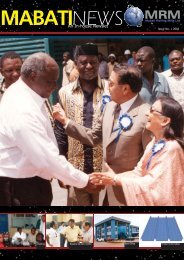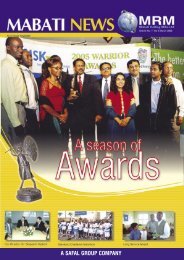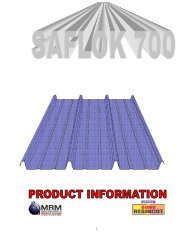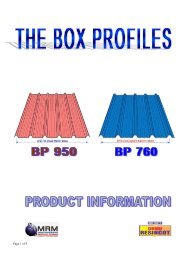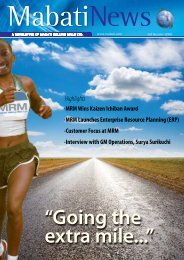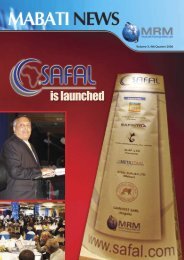MRM pg 16-20.pdf - Mabati Rolling Mills
MRM pg 16-20.pdf - Mabati Rolling Mills
MRM pg 16-20.pdf - Mabati Rolling Mills
- No tags were found...
Create successful ePaper yourself
Turn your PDF publications into a flip-book with our unique Google optimized e-Paper software.
Commisioning misioning of Pickling plant at Mariakani<br />
MABATINEWS<br />
In the true spirit of Kaizen principles of continuous improvement,<br />
<strong>MRM</strong> invested over US$9 million last year to create a new<br />
pickling line that was commissioned on October 3, 2006 this<br />
year by the Minister for Finance Hon. Amos Kimunya. In his key<br />
note address Hon. Kimunya, acknowledged the huge investment<br />
the shareholders had made into the state-of-the-art technology.<br />
He recognised that the results of the new line will shift the level of<br />
manufacturing to a completely new level of competitiveness. He<br />
noted and appreciated the advantages of the new line. <strong>MRM</strong> will<br />
now widen its raw material sources, particularly in the hot rolled<br />
coils. It was hitherto confined to a few selected suppliers. He also<br />
noted that the investment will give the company the advantage of<br />
flexibility, innovation and creativity in a very competitive market.<br />
He acknowledged that such an investment demonstrated<br />
the confidence <strong>MRM</strong> shareholders had in doing business in<br />
Kenya. Hon Kimunya noted with appreciation that the plant took<br />
into consideration environmental concerns and made further<br />
investment in Acid Regeneration Plant which allows the acid to be<br />
completely recycled. The facility has a capacity to handle and treat<br />
coils up to 200,000 tonnes per year.<br />
The minister observed that <strong>MRM</strong>’s overall business operations<br />
make a significant contribution to the country’s economic growth<br />
and development. He said that the government is committed to<br />
creating a conducive and enabling environment where businesses<br />
will find it easier and more friendly to do business.<br />
Since private sector plays and important role in the country’s<br />
economic development the government is committed to support<br />
private sector investment initiatives. Appropriate legislation and<br />
streamlining of administrative bottlenecks will continue to be<br />
introduced at various levels of operations of government to make<br />
it easier for businesses to operate.<br />
The Minister pointed out how Kenya has gained high rating<br />
by where it was rated 4th in the Sub-Saharan Africa behind<br />
Botswana, South Africa and Nigeria. The World Bank has rated<br />
Kenya 6th in Africa in respect of doing business. Obviously there<br />
is going to be increased government effort to consolidate what<br />
is good and improve on areas that can facilitate private sector<br />
investment in the country.<br />
The government is also investing in ICT and communications<br />
connectivity to make it easier for businesses to share vital<br />
information necessary for growth and global trade. The Minister<br />
spoke about refunds and said the government has scaled up from<br />
KSh614million to KSh900million. He also said there is a provision of<br />
KSh1.5billion for KRA to clear the backlog.<br />
The Minister praised the <strong>MRM</strong> management and welcomed<br />
the opportunity to officially visit the plant and commission the<br />
Pickling Line. The inauguration ceremony was attended by among<br />
others: the Board Directors,<br />
Managers, Workers,<br />
Customers, Well wishes and<br />
community leaders.<br />
After<br />
the inauguration ceremony<br />
Hon. Kimunya visited and<br />
toured the nearby Kaluworks<br />
Plant which is also owned<br />
by the same shareholders<br />
of <strong>MRM</strong>.<br />
<strong>16</strong><br />
M A B A T I N E W S<br />
Continued on page 18>>
awards<br />
MABATINEWS<br />
OVERALL CORPORATE CP AWARD:<br />
awarded to the organization with<br />
outstanding cleaner production<br />
management initiatives<br />
CP LEADERSHIP AWARD:<br />
given to the company that demonstrates<br />
its openness and communication<br />
regarding cleaner production and other<br />
environmental matters to workers and<br />
the surrounding community<br />
SOLID WASTE REDUCTION AWARD:<br />
given to the company that has achieved<br />
significant solid waste reduction in<br />
the implementation of its cleaner<br />
production initiatives<br />
REDUCTION IN GASEOUS EMISSIONS:<br />
given to the company that has achieved<br />
significant reduction in gaseous<br />
emissions through implementation of<br />
cleaner production initiatives<br />
WASTEWATER REDUCTION AWARD:<br />
given to the company that has achieved<br />
significant wastewater reduction in<br />
the implementation of its cleaner<br />
production initiatives<br />
CP INNOVATION AWARD:<br />
given to the company that promotes voluntary<br />
complementary initiatives like designing products<br />
for environment, EMS, green supply management<br />
and other innovative eco-efficiency principles.<br />
KRA 2006 DISTINGUISHED<br />
TAXPAYER AWARD<br />
OCCUPATIONAL HEALTH AND<br />
SAFETY AWARD:<br />
given to the organization with most<br />
significant reduction in occupational<br />
health and safety risks and hazards<br />
M A B A T I N E W S 17
Cleaner Production Initiatives at<br />
<strong>Mabati</strong> <strong>Rolling</strong> <strong>Mills</strong> Ltd<br />
By Francis Muthama<br />
Cleaner production is a preventive<br />
environmental management strategy<br />
that focuses on products, processes<br />
and services. Cleaner Production aims to<br />
reduce waste generation at source leading to<br />
economic savings as well as protection of the<br />
environment. Its techniques of application can<br />
be broadly classified as waste minimization at<br />
source, on-site recovery and reuse, recycling,<br />
good house keeping, energy efficiency, risk<br />
management, equipment modification,<br />
input substitution, better process control,<br />
technology change, product modification and<br />
responsible corporate management.<br />
Cleaner Production describes a preventive<br />
approach to environmental management.<br />
It is called a “win–win” strategy, because it<br />
protects the environment, the consumer<br />
and the workers while at the same time<br />
improving industrial efficiency, profitability<br />
and competitiveness. It focuses on processes,<br />
productivity and services.<br />
Reduce the consumption of raw materials<br />
and energy<br />
Eliminate as far as possible the use of toxic<br />
and dangerous materials<br />
Reduce at source the quantity and toxicity<br />
of all emissions and waste generated and<br />
released<br />
Principles of Cleaner Production<br />
Prevention: Preventing as much as possible<br />
the generation of waste at source<br />
Source reduction: Waste is reduced at<br />
every process stage or service step<br />
Raw material optimization: Conserving<br />
raw materials and switching to renewable<br />
resources<br />
Substituting toxic inputs with less toxic<br />
ones<br />
To recover, recycle and re-use of byproducts<br />
and waste<br />
Reducing environmental, health and safety<br />
impacts<br />
<strong>MRM</strong> production processes aim for:<br />
1. Waste Management and control Systems<br />
Energy Conservation: An energy audit is<br />
performed identifying areas where there<br />
are high power consumption and giving<br />
solutions on minimizing losses.<br />
Key performance Indicators: the company<br />
has formulated objectives and targets<br />
for minimizing waste, reducing resources<br />
depletion.<br />
Methodology or a procedure for identifying<br />
areas of inefficient use of resources and<br />
poor management of waste: This is done<br />
through internal audits, Systems audits and<br />
Monitoring of consumables.<br />
Material Balance: this helps to explain<br />
unaccounted raw materials that end up as<br />
waste and the yield.<br />
Housekeeping: Implementation of Kaizen<br />
Tools such as 5K’s help control wastes and<br />
keeps the plant neat and tidy<br />
2. Process Performance, Monitoring and<br />
control<br />
Equipment performance: measured and<br />
monitored via the overall equipment<br />
efficiency analysis which takes into account<br />
the performance factor, availability & quality<br />
factors.<br />
Machine down time: Logged and analyzed<br />
with reasons.<br />
Rejections and Rework: Minimal rejections<br />
and rework is generated.<br />
Process Monitoring: Automation &<br />
computerization of the Plants, Calibration of<br />
measuring equipment / instruments, planned<br />
maintenance and in-house Laboratory<br />
analysis.<br />
3. Systems to improve services<br />
Maintenance: Autonomous Maintenance, And<br />
Periodic maintenance schedule is followed.<br />
Cross Functional Teams: These are groups<br />
working as a team on any areas of improvement<br />
i.e. different experts from different departments<br />
coming together to brainstorm on a common<br />
problems in TQM projects, Gemba – Kaizen<br />
projects / interventions ISO 14001 continual<br />
improvement programs.<br />
Computerized systems of data acquisition,<br />
storage and reporting: These include<br />
Production Management System (PMS) and<br />
Coil tracking software (Access)<br />
4. Fire, Health and Safety<br />
Fire<br />
A general fire fighting procedure is<br />
available throughout the factory. However<br />
at departmental levels, detailed fire control<br />
procedures specific to the particular type of<br />
fire are available.<br />
Health<br />
There is periodic medical examination incase<br />
of workplace sickness. Occupational Health<br />
and Safety procedure is followed.<br />
Safety<br />
Workers are provided with personal protective<br />
equipment which are relevant to their areas of<br />
operation.<br />
Issuance and compliance of use of Personal<br />
Protective Equipment is at 100%.<br />
First aiders have been trained and<br />
allocated to cover 24 hours plant operation.<br />
Well stocked first aid kits have been placed at<br />
strategic areas in the plant<br />
5. Environmental Practices<br />
1. Environmental Impact Assessments before<br />
commencing any new project<br />
2. Corporate Reporting<br />
IFC reports and NEMA environmental<br />
assessments (self audits)<br />
3. Measuring and Monitoring<br />
4. Continual Improvement Programmes<br />
These are done as Gemba Kaizen<br />
Interventions and Continual Improvements<br />
under ISO 14001<br />
6. Innovation<br />
Recover, recycle and re-use wastes<br />
Product water from the reverse osmosis<br />
plant is used as boiler feed water. This<br />
water is recovered as condensate and<br />
used as Rinse water and Scrubber water at<br />
the Pickling Line. This water is collected as<br />
rinse water for use in the Acid Regeneration<br />
process to Produce Regenerated Acid.<br />
Reject water from the reverse osmosis<br />
plant is collected and used in toilets and<br />
cooling water for mechanical seals of<br />
pumps at Pickling and Acid Regeneration<br />
Plants. This cooling water is collected<br />
treated at the Pickling line ETP and used<br />
as water for flushing in Toilets.<br />
Recovered water from the Sewerage<br />
treatment plant is recycled for use in toilets<br />
within the factory and at the technical<br />
school.<br />
Treated Water from the CRM effluent<br />
treatment plant is used for Agriculture<br />
within the plant.<br />
Rain water is Harvested and stored in<br />
ponds. This water is utilized as process<br />
water.<br />
Hydrochloric acid is recovered from used<br />
waste acid form the pickling line through<br />
the process of regeneration and re-used in<br />
the Pickling Process.<br />
Waste Minimization at Source<br />
This done through continual improvement<br />
programmes , raw material substitution and<br />
use of better technologies.<br />
Awards won<br />
Occupational Health and Safety Award<br />
CP Innovation Award<br />
18<br />
M A B A T I N E W S
M A B A T I N E W S 19
20<br />
M A B A T I N E W S



